If you’re like me, raspberries make you happy. They look scrumptious, taste wonderful, and store easily. Yes, you heard it here. They store easily. So don’t weep over the short raspberry season we have. Embrace it, gather up the fruits, and learn to preserve that wonderful goodness for the deep dark recesses of winter when you need a little spring brightness!
There are two methods of easily preserving raspberries: dehydrating and freezing. I personally prefer frozen raspberries, but know that for long-term storage, I cannot rely on my freezer exclusively, so I also dehydrate raspberries to have a full stock all year long.
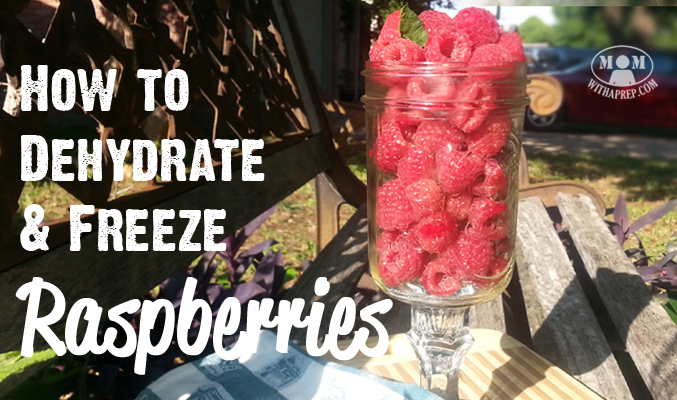

Nutritional Info
Besides tasting so good, raspberries also offer great nutritional value. They are high in dietary fiber (one cup contains 8.5 grams of dietary fiber – about 20% of your daily recommended intake), are rich in copper and manganese (which helps with joint health), Vitamin C, A & K, and are full of all sorts of good stuff to help fight off cancer, protect your DNA and more.
Raspberries have significantly high levels of phenolic flavonoid phytochemicals such as anthocyanins, ellagic acid (tannin), quercetin, gallic acid, cyanidins, pelargonidins, catechins, kaempferol, and salicylic acid. Scientific studies show that these antioxidant compounds in these berries have potential health benefits against cancer, aging, inflammation, and neurodegenerative diseases.
With all that raspberries have going for them including their taste, let’s get started preserving them!
First Steps for Preserving Raspberries
- Wash and remove debris
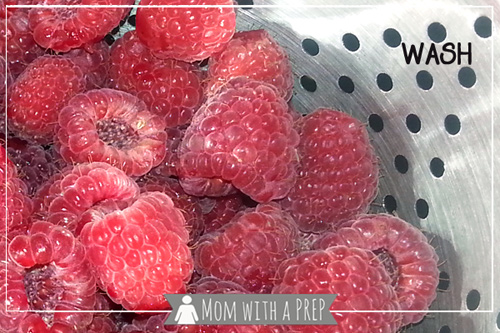
2. Pick through raspberries. Remove any that are spongy, deep-dark red or smashed. These can go in the freezer pile
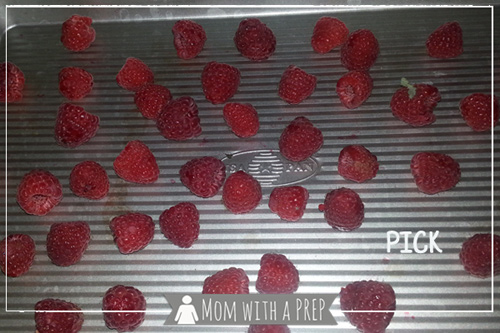
3. Air dry to remove moisture. For both the dehydrating and the freezing process, excess moisture isn’t always good.
How to Dehydrate Raspberries: Easy Step-by-Step Guide
After you’ve picked through your raspberries to get the best of the best, begin putting them on your trays. You can start outputting them in perfect little soldier rows like this:
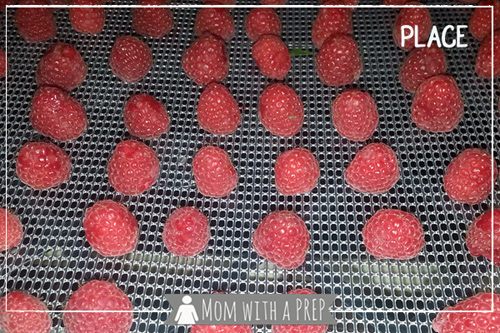
But…you’ll probably get tired of that and want to just toss them all on like this
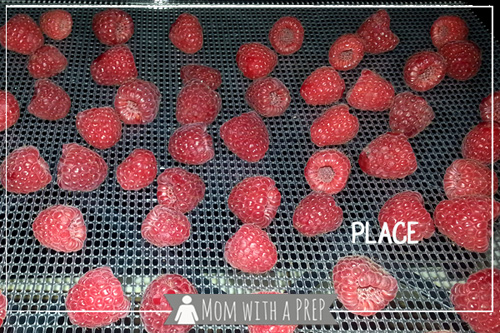
Either way, I place mine fairly close together, while still allowing plenty of space between to let the airflow nicely. They do not shrink much at all.
Set your Dehydrator to 135F (or the fruit setting of your machine) and allow it to dry from 12-18 hours. This depends on your humidity level, how juicy your fruit is, and what kind of dehydrator you’re working with. I use an Excalibur and mine were dry in about 13 hours. My Square American Harvester took about 15 hrs.
While you can do this with your oven, you’ll have to keep a close eye out on your raspberries. 140F for 6-9 hours, stirring every 2 hours or so.
What Does Dehydrated Raspberry Look Like?
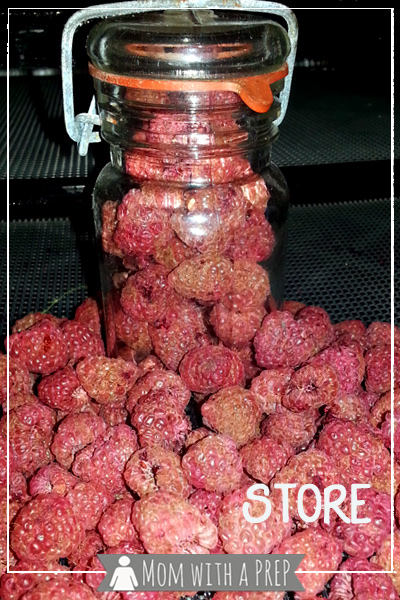
Completely dehydrated raspberries are dry, crisp and paper-like. They lose a little bit of their bright red color, but don’t worry – they’re okay!
I keep mine stored in small airtight containers with an oxygen absorber. You can also use a vacuum sealer to dry seal the raspberries into canning jars for long-term storage as there is a lot of extra air in a jar.
How to Use Dehydrated Raspberries
My husband loves snacking on them right from the jar. I, however, prefer to reconstitute them in a little bit of hot water before using them in baked goods (and then use that water as part of the moisture for said recipe). Our family’s favorite way to use them is to reconstitute them along with cooking oatmeal and add some cream at the end. YUMMY!
How to Freeze Raspberries
From the misfits, you might have pulled from your dehydrating batch, or if you’re freezing all of your raspberries, place them on cookie sheets in a single layer. Flash freeze them for five to six hours.

Transfer your raspberries to freezer-grade zip-top bags. You can choose to store them in small quantities that are perfect for popping into smoothies, or you can store them in larger bags. But work quickly. Raspberries actually thaw quite quickly and will begin to stick together in your bags. Work with only one tray at a time.
To store, remove all of the air from your freezer bag. (I happen to use a straw to suck out the extra air as trying to use pressure to do so might crush the raspberries).
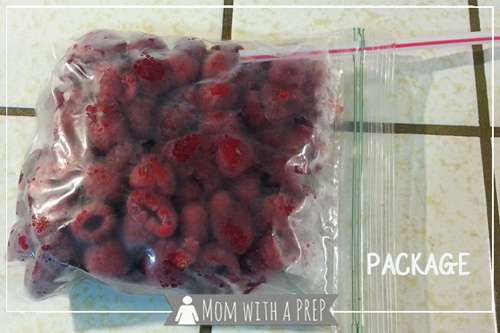
Label and freeze your raspberry packages. While conventional wisdom will tell you these are only good for about 3-6 months in the freezer, I can easily get through a year if I have enough raspberries to actually last that long. The quality does diminish, so I would never serve them as a garnish on ice cream, but for oatmeal, smoothies, or even as part of a raspberry sauce, they work just fine!
Here are some other ways you can preserve the bounty of summer!
YOUR THOUGHTS – what is your favorite way to eat raspberries?
Tools you might need: Excalibur Dehydrator or American Harvester Dehydrator | Ball Canning Jars | Vacuum Sealer | Zip Top Bags
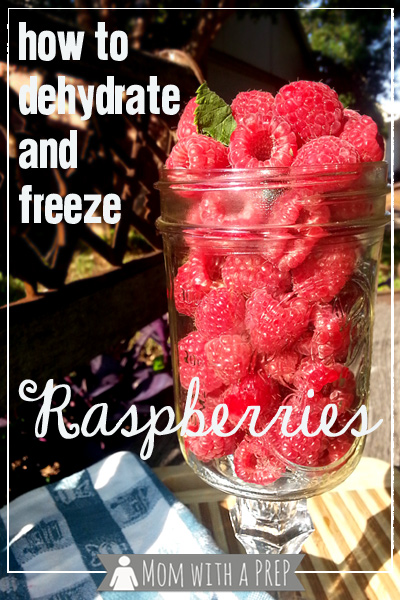
Katy Willis is a writer, lifelong homesteader, and master herbalist, master gardener, and canine nutritionist. Katy is a preparedness expert and modern homesteader practicing everyday preparedness, sustainability, and a holistic lifestyle.
She knows how important it is to be prepared for whatever life throws at you, because you just never know what's coming. And preparedness helps you give your family the best chance to thrive in any situation.
Katy is passionate about living naturally, growing food, keeping livestock, foraging, and making and using herbal remedies. Katy is an experienced herbalist and a member of the CMA (Complementary Medical Association).
Her preparedness skills go beyond just being "ready", she's ready to survive the initial disaster, and thrive afterward, too. She grows 100% organic food on roughly 15 acres and raises goats, chickens, and ducks. She also lovingly tends her orchard, where she grows many different fruit trees. And, because she likes to know exactly what she's feeding her family, she's a seasoned from-scratch cook and gluten-free baker.
Katy teaches foraging and environmental education classes, too, including self-sufficient living, modern homesteading, seed saving, and organic vegetable gardening.
Katy helps others learn forgotten skills, including basic survival skills and self-reliance.
She's been published on sites such as MSN, Angi, Home Advisor, Family Handyman, Wealth of Geeks, Readers Digest, and more.

